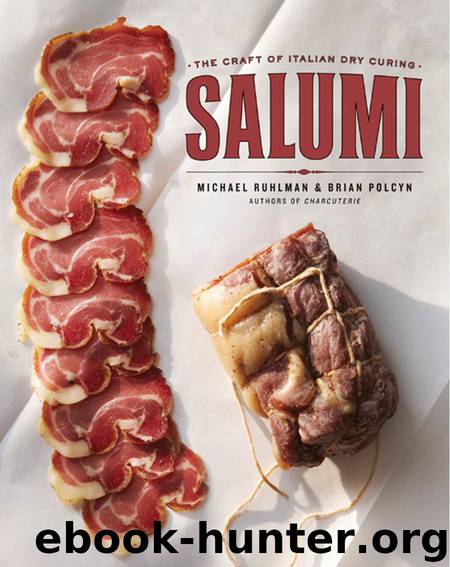Salumi: The Craft of Italian Dry Curing by Ruhlman Michael & Polcyn Brian

Author:Ruhlman, Michael & Polcyn, Brian [Ruhlman, Michael]
Language: ara
Format: epub
Publisher: W. W. Norton & Company
Published: 2012-08-27T00:00:00+00:00
Yield: Two 1.75-pound/800-gram salami
Soppressata Roman-Style
In Italy, soppressata varies from region to region. Pressato is Italian for pressed, and a fat salame can be pressed into an oval shape to facilitate drying, as we do here. Tuscan soppressata is not salami at all but rather salume made from meat, fat, skin from the head, and other trim, cooked with aromatics in a liquid until everything is tender. The mixture is stuffed into a large casing, and the gelatinous stock holding all the morsels together in a large casing will be sliceable when chilled; see page 184 for a recipe. Most often, though, soppressata is a dry-cured salame, as it is here, spicy from pepper and chile flakes, and with the fat ground through a larger die than the meat so the chunks are big and distinct.
4 pounds/1815 grams pork shoulder butt, cut into large dice
1 pound/450 grams pork back fat, cut into large dice
2 ounces/56 grams sea salt
1 teaspoon/7 grams DQ Curing Salt #2
1 tablespoon/7 grams finely ground black pepper
1 tablespoon/7 grams red pepper flakes
1 tablespoon/9 grams dextrose
½ cup/125 milliliters dry white wine
1 tablespoon/10 grams Bactoferm (live starter culture; see Sources, page 267)
2 tablespoons/30 milliliters distilled water
Mold 600 (see page 70 for more information and page 267 for sources) (optional)
Two 18-inch/45-centimeter lengths beef middle, soaked in tepid water for at least 20 minutes and rinsed
1. Partially freeze the meat and fat.
2. Grind the pork through a ¼-inch/6-millimeter (medium) die into the bowl of a stand mixer. Grind the fat through a ⅜-inch/9-millimeter (large) die into the bowl.
3. Add the salt, curing salt, pepper, red pepper flakes, and dextrose and mix with the paddle attachment until the ingredients are thoroughly combined. Add the wine, mixing until incorporated. Cover and refrigerate for at least 8 hours, and up to 24 hours.
4. Dissolve the Bactoferm in the distilled water. Mix the meat again, using the paddle attachment, adding the culture as you do so and mixing until the starter culture is well distributed and the meat is tacky.
5. Tie one end of each casing using a bubble knot (see page 122). Stuff the sausage into the casings, and tie each one off using another bubble knot. Using a clean needle, sausage pricker, or knife tip, poke holes all over the sausage, especially where there may be air pockets. If you’re using weight to determine doneness, weigh the sausages and record the results.
6. Put the sausages on a baking sheet lined with parchment paper. Cover with another sheet of parchment, put another baking sheet on top, and weight it down with 8 to 10 pounds (4000 to 5000 grams) of weights. Refrigerate for 3 days.
7. Hang the sausages to incubate for about 24 hours in a warm place (ideally 80
degrees F./29 degrees C. and 80% humidity).
8. Hang the sausages in the drying chamber. If using the mold culture, mist them according to the package instructions. The salami are ready when they have lost about 30 percent of their raw weight, about 3 weeks.
Download
This site does not store any files on its server. We only index and link to content provided by other sites. Please contact the content providers to delete copyright contents if any and email us, we'll remove relevant links or contents immediately.
| Eastern European | English, Scottish & Welsh |
| French | German |
| Greek | Hungarian |
| Irish | Italian |
| Mediterranean | Polish |
| Portuguese | Russian |
| Scandinavian | Spanish |
| Turkish |
Biscuits: A Savor the South Cookbook by Belinda Ellis(3901)
Al Roker's Hassle-Free Holiday Cookbook by Al Roker(3175)
A Jewish Baker's Pastry Secrets: Recipes from a New York Baking Legend for Strudel, Stollen, Danishes, Puff Pastry, and More by George Greenstein(3100)
Ottolenghi Simple by Yotam Ottolenghi(3037)
Trullo by Tim Siadatan(2984)
The French Women Don't Get Fat Cookbook by Mireille Guiliano(2975)
Better Homes and Gardens New Cookbook by Better Homes & Gardens(2949)
Bake with Anna Olson by Anna Olson(2928)
Panini by Carlo Middione(2823)
Hot Thai Kitchen by Pailin Chongchitnant(2804)
Nigella Bites (Nigella Collection) by Nigella Lawson(2768)
Momofuku by David Chang(2761)
Modern French Pastry: Innovative Techniques, Tools and Design by Cheryl Wakerhauser(2723)
Salt, Fat, Acid, Heat: Mastering the Elements of Good Cooking by Nosrat Samin(2653)
Tapas Revolution by Omar Allibhoy(2532)
Classic by Mary Berry(2499)
Solo Food by Janneke Vreugdenhil(2489)
Best of Jane Grigson by Jane Grigson(2466)
Okonomiyaki: Japanese Comfort Food by Saito Yoshio(2387)
